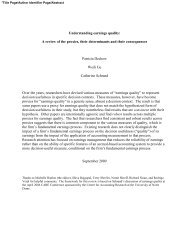Sony's Battle for Video Game Supremacy - MIT Sloan School of ...
Sony's Battle for Video Game Supremacy - MIT Sloan School of ...
Sony's Battle for Video Game Supremacy - MIT Sloan School of ...
You also want an ePaper? Increase the reach of your titles
YUMPU automatically turns print PDFs into web optimized ePapers that Google loves.
SONY'S BATTLE FOR VIDEO GAME SUPREMACY<br />
John Sterman, Kahn Jekarl, Cate Reavis<br />
19<br />
By 2001, sales <strong>of</strong> video games topped $6 billion in the United States.F<br />
F While the retail cost <strong>of</strong> games<br />
had stayed the same, development budgets were increasing, schedules were lengthening, and<br />
production values were at their highest level. On average, 20 to 30 people worked <strong>for</strong> 18 months to<br />
20<br />
develop a game <strong>for</strong> the PS2 and each game cost upwards <strong>of</strong> $5 million to develop.F<br />
F The industry was<br />
becoming a blockbuster-driven market. The top three selling games in 2001 (Grand Theft Auto 3,<br />
21<br />
Madden NFL 2002, and Metal Gear Solid 2) totaled over $240 million in sales.F<br />
F<br />
As more hit titles were created by independent developers, publishers found themselves paying<br />
royalty fees that ranged from 10% to 40% <strong>of</strong> the retail price <strong>of</strong> s<strong>of</strong>tware once development costs were<br />
22<br />
recouped.F<br />
F In an ef<strong>for</strong>t to avoid paying royalties, publishers began acquiring talented development<br />
studios. In 2001, UbiS<strong>of</strong>t, acquired Red Storm Entertainment, the developer <strong>of</strong> Tom Clancy’s<br />
Rainbow Six games, <strong>for</strong> $43 million and a year later Micros<strong>of</strong>t purchased Rare Ltd, known <strong>for</strong> its<br />
James Bond titles, <strong>for</strong> a sizable $375 million. As publishers’ pockets got deeper, acquisitions became<br />
more commonplace (Figure 3). In time, purchasing talented development studios became a defensive<br />
measure <strong>for</strong> publishers to prevent competitors from acquiring top talent. By 2006, the largest<br />
publishers owned several studios including Activision (11 studios) and THQ (14 studios).<br />
Figure 3<br />
16<br />
14<br />
12<br />
10<br />
8<br />
6<br />
4<br />
2<br />
0<br />
Source: Dan Lee Rogers, “The End <strong>Game</strong>: How Top Developers Sold Their Studios, Part 1,”<br />
http://gamasutra.com/features/20040303/rogers_o1.shtml<br />
19 Susan Stellin, “Brisk Sales <strong>for</strong> <strong>Video</strong> <strong>Game</strong>s,” The New York Times, November 25, 2002.<br />
20 Felix Vikhman, “Back from the Brink,” National Post, September 1, 2002.<br />
21 International Development Group<br />
<strong>Game</strong> Developer Acquisitions 1991-2004<br />
(2003 data reflects Jan-Mar)<br />
1991<br />
1992<br />
1993<br />
1994<br />
1995<br />
1996<br />
1997<br />
1998<br />
1999<br />
2000<br />
2001<br />
2002<br />
2003<br />
2004<br />
22 Peter J. Coughlan, “Note on Home <strong>Video</strong> <strong>Game</strong> Technology and Industry Structure,” HBS Case No. 700-107, June 13, 2001.<br />
Rev: December 8, 2011 10
















